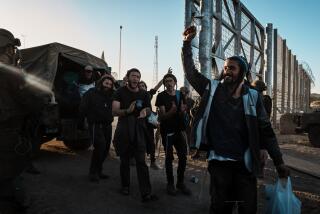Bombs Outnumber Cucumbers on Farm
Farmers are trying to make the desert bloom, but their main harvest since the Gulf War has been unexploded cluster bomblets dropped by allied pilots on farms the Iraqis had turned into military camps.
“The bomb squad shows up once a week to clear away mines and bombs,” said Ronald Roosenbloom, a 38-year-old Dutchman. He is the only European farm manager left in the Wafra region, which has 800 agricultural operations, most of them truck or poultry farms.
Seventy unexploded weapons have been found on the farm Roosenbloom manages for a wealthy Kuwaiti family.
Farmers say the Iraqi invasion in August, 1990, may have destroyed their chances of transforming the sandy wastes into a breadbasket for Kuwait.
The invaders and nomadic Bedouins stripped the farms of everything that could be moved, they said. Right after liberation, what the farmers call Saudi Arabia’s “agriculture Mafia” moved in and gained control of the produce market.
Water from the Wafra region’s pumping station was cut off two days after the invasion, and the desert swiftly reclaimed the farms.
Chickens died by the hundreds of thousands. Date palms went limp. Fruit shriveled on the vines.
“One day without water and all this is dust,” said Roosenbloom, who ran farms in the Kalahari desert of West Africa for a decade before coming to Kuwait five years ago.
Losses have totaled hundreds of millions of dollars. Hussein Quattan, a member of a prominent trading family who has one of the largest farms, estimated the losses on his 18 1/2 acres alone at $2.65 million.
“I don’t think it’ll ever go back to the way it was,” Roosenbloom said.
Between 1983 and 1986, the government provided free land and greenhouses to increase agricultural production. Later, it subsidized prices. Kuwait’s larger-scale farmers sought to make the emirate self-sufficient in such staples as poultry, lamb, tomatoes and cucumbers.
Before the invasion, most agricultural plots were gardens of 50 square meters belonging to well-to-do Kuwaitis who tended them on weekends.
Of 150 sizable farms established by rich merchants and members of the ruling Al Sabah family, only about 30 are back in business.
As a motorist approaches Wafra, 60 miles southwest of Kuwait City, hardy desert pines planted as windbreaks seem to spring up suddenly along the flat highway.
On both sides of the road are abandoned tanks, cluster-bomb casings and signs saying “Danger--Mine Fields.” Frames of destroyed greenhouses rise from the sand like the skeletons of beached whales.
Lack of compensation from either Iraq or the Kuwaiti government makes even the richest merchant families hesitant about reinvesting in agriculture.
The emirate’s prewar foreign population of about 1.5 million has been halved, so the demand has collapsed for cabbages, mushrooms, lettuce, zucchini, strawberries and other greenhouse products that most Kuwaitis shun.
Still, with the help of subsidized water and a year-round growing season, farms that can function make money.
Nasser Bedah, said he clears about $40,000 a month on vegetables from his eight farms.
Because the Interior Ministry has stopped issuing visas to foreign laborers, however, most farms do not have the workers they need.
Since the war, the Saudis have gained a virtual stranglehold on the region’s vegetable market. Produce the Kuwaitis try to export usually ends up rotting at the border.
Although the Kuwaiti government has promised more support, farmers complain of official neglect.
More to Read
Start your day right
Sign up for Essential California for news, features and recommendations from the L.A. Times and beyond in your inbox six days a week.
You may occasionally receive promotional content from the Los Angeles Times.






